Most people think that booking travel involves choosing between round-trip, one-way, and multi-city trips. The reality is that there’s a much wider range of options available to you, especially if you happen to be planning more than one trip at a time.
The term “nested trips” encompasses all the possibilities beyond a simple round-trip booking, and it can be well worth your time to experiment with different options in order to extract significant value.
This may involve using a combination of different loyalty programs and cash fares to take advantage of multiple sweet spots, and it generally requires a fair bit of legwork for everything to work seamlessly.
How Do Nested Trips Work?
A nested trip is simply any occasion when you book two or more itineraries such that they overlap in some way; that is, one booking is nested within the other.
You can think of the classic “side-trip” as an example. Travellers who frequently visit Europe know that it’s a common practice to book a round-trip to a gateway European city, and then secure cheap flights to other places on low-cost carriers like Ryanair or EasyJet.
Doing so is usually much cheaper than trying to string together all your desired European destinations on a single multi-stop ticket.
For example, you could hop on a direct flight from Toronto to Paris using Aeroplan points for Air Canada Signature Class or Air France/KLM Flying Blue miles for Air France business class. This is booked as part of a round-trip flight that will eventually get you back home.
Once you’re in Paris, you could then visit Barcelona and Rome before flying back to Paris, all on cash fares with ultra-low-cost carriers.
After getting back to Paris, you’d then simply hop on the flight back to Toronto.
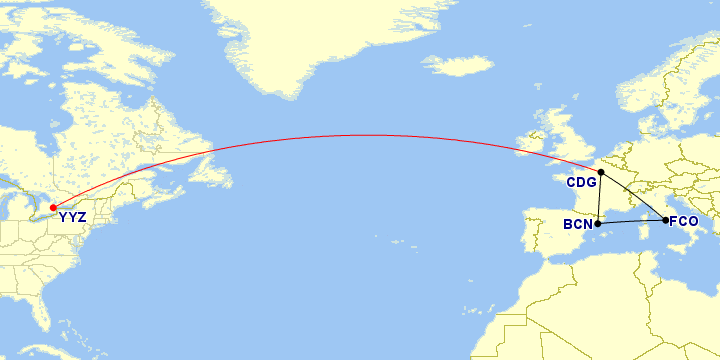
By leveraging back-to-back ticketing, though, some creative folks (whose travel patterns happen to involve the same destination more than once) are able to skirt around the minimum stay requirements and book their shorter trips for the lower price.
Here’s how this works. Let’s imagine a price-sensitive business traveller (perhaps she’s self-employed or unusually altruistic to her employer) needs to make two very quick trips from Montreal to London, spaced two weeks apart.
If she booked this as two simple round-trips, she’d have to pay the relatively higher fare – the one with no three-night minimum stay requirement – for both bookings.
Ticket 1 (2 nights, $$$):
Oct 1: YUL – LHR
Oct 3: LHR – YUL
Ticket 2 (2 nights, $$$):
Oct 14: YUL – LHR
Oct 16: LHR – YUL
On the other hand, if she booked one round-trip from Montreal to London (with the return leg two weeks later), and nested a second round-trip from London to Montreal in-between, she’d be able to pay the relatively lower fare – the one with a three-night minimum stay requirement – on both bookings!
Ticket 1 (15 nights, $):
Oct 1: YUL – LHR
Ticket 2 (11 nights, $):
Oct 3: LHR – YUL
Oct 14: YUL – LHR
Oct 16: LHR – YUL
Airlines frown upon this sort of behaviour, since your back-to-back ticketing is costing them the revenue they’d otherwise earn if you had booked the tickets the normal way and had paid for the less restrictive fare. They’ve been known to suspend frequent flyer accounts of passengers who routinely employ this practice.
Indeed, if we look at Air Canada’s conditions of carriage, for example, we see the following:
Air Canada specifically prohibits the practices commonly known as:
“Back To Back Ticketing” – the combination of two or more round-trip fares end to end for the
purpose of circumventing minimum stay requirements;
If your circumstances are such that you would benefit from back-to-back ticketing, then, it’s often recommended to book your two tickets on different carriers (say, Air Canada and British Airways), in order to avoid detection and any possible negative repercussions.
The Award Angle
It may well be the case that the true power of nested trips is unlocked when combining multiple award chart sweet spots in order to craft some truly incredible trips.
After all, the more individual sweet spots you can take advantage of, the more outstanding value you can squeeze out of your points.
Let’s suppose that you have a nice stash of Aeroplan points and British Airways Avios, and want to embark on a round-the-world trip hitting up the Middle East, a few countries in South East Asia, China, and Japan.
With Aeroplan, recall the “Asia 3” sweet spot gives you up to 11,000 miles to fly while still paying just 87,500 Aeroplan points in business class, plus an additional 5,000 points for a stopover. If you were to fly above the 11,000-mile threshold, the cost jumps to 115,000 points, which is a fairly sizeable increase.
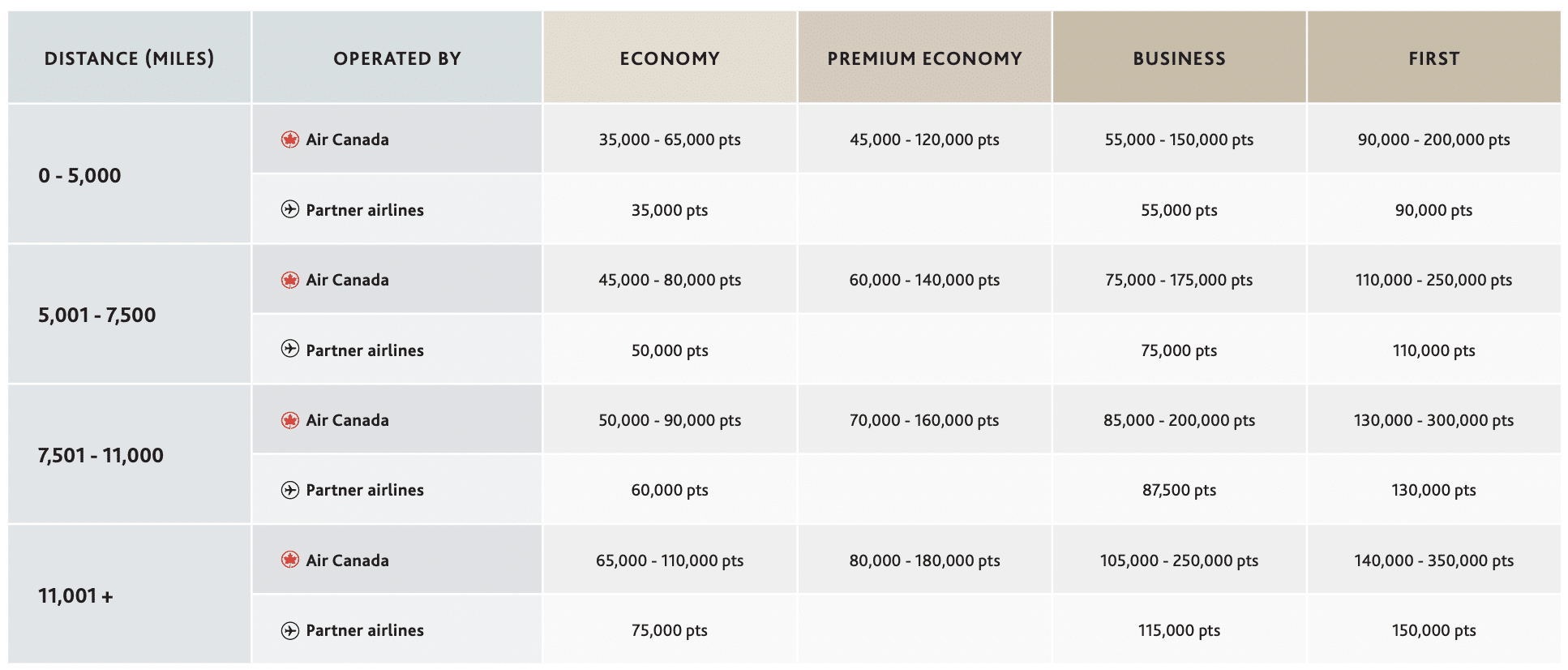
Furthermore, with Aeroplan’s rules, you’re able to have a stopover on each one-way bound. This means you’d be limited to just three spots to visit on your trip without adding a third (or even fourth) one-way bound.
Before you start agonizing over which destination to sacrifice, or resign to shelling out the additional Aeroplan points, think about whether there might be a smart way to incorporate a nested trip into your overall itinerary.
Recall that one of the better uses of British Airways Avios is with short-haul flights within Asia. For this trip, we’d consider looking at flights with Malaysia Airlines or Cathay Pacific to help keep the trip’s total cost down.
For example, you could fly from Toronto to Abu Dhabi, have a stopover, and then continue onward to Guangzhou, all with Etihad Airways. This portion of the trip would cost 92,500 Aeroplan points, as it measures under 11,000 miles and we’ve added a stopover in Abu Dhabi.
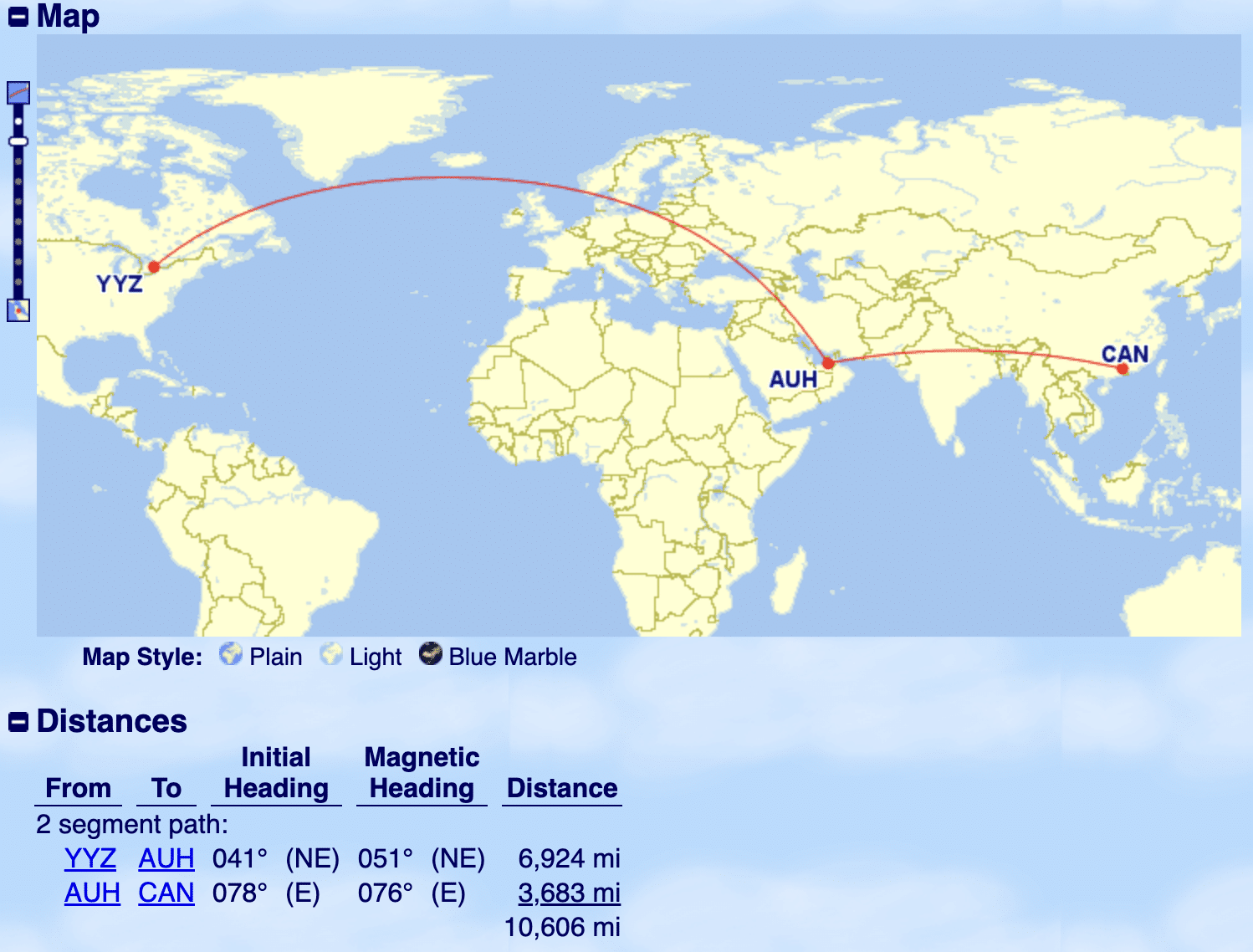
From there, you could make your way by land to Hong Kong before flying to Kuala Lumpur for 22,000 Avios. After visiting Malaysia, you then continue onwards to Jakarta with Malaysia Airlines, for 16,500 Avios in business class.
On the way back home, you could fly to Japan with All Nippon Airways or via Singapore with Singapore Airlines, before heading back to Toronto via Chicago with All Nippon Airways and Air Canada. Since this portion of your trip measures less than 11,000 miles, it also costs 92,500 Aeroplan points.
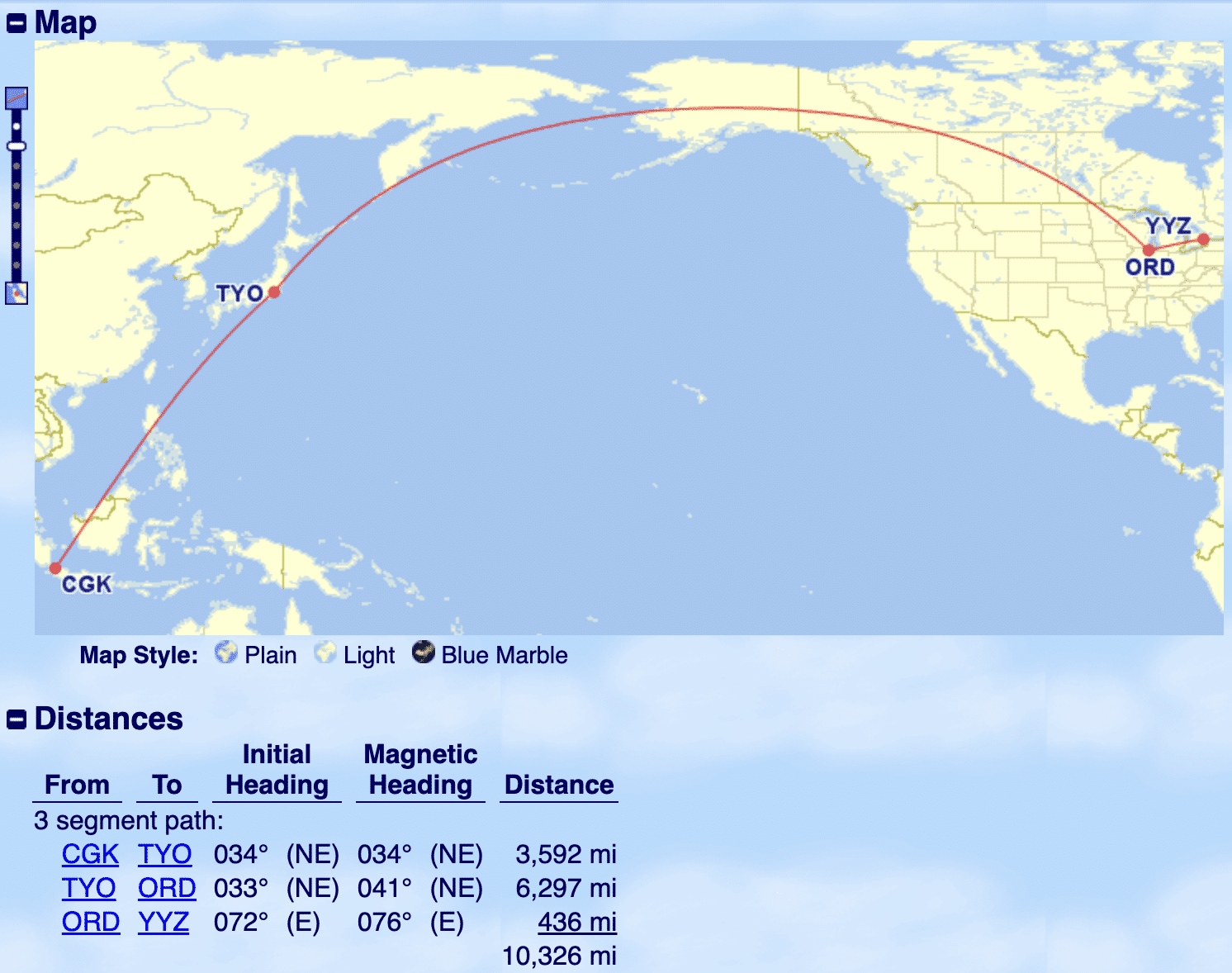
In the above example, you’re hitting up all of the destinations that you wanted to without spending more points than you would have with a single program.
For example, if you were to visit all of the destinations with Aeroplan, you’d have to make three separate one-way bookings that total at least 235,000 points:
- Toronto to Abu Dhabi (stopover) to Guangzhou (destination) for 92,500 points
- Hong Kong to Kuala Lumpur (stopover) to Jakarta (destination) for 50,000 points
- Jakarta to Tokyo (stopover) to Chicago to Toronto (destination) for 92,500 points
By nesting a trip within Asia using Avios, you wind up saving around 11,000 points along the way:
- Toronto to Abu Dhabi (stopover) to Guangzhou (destination) for 92,500 Aeroplan points
- Hong Kong to Kuala Lumpur for 22,000 Avios
- Kuala Lumpur to Jakarta for 16,500 Avios
- Jakarta to Tokyo (stopover) to Chicago to Toronto (destination) for 92,500 Aeroplan points
You’re saving points by nesting an Avios redemption within an Aeroplan redemption, and utilizing sweet spots in multiple programs. If you took advantage of an Avios transfer bonus promotion, then your savings would increase accordingly.
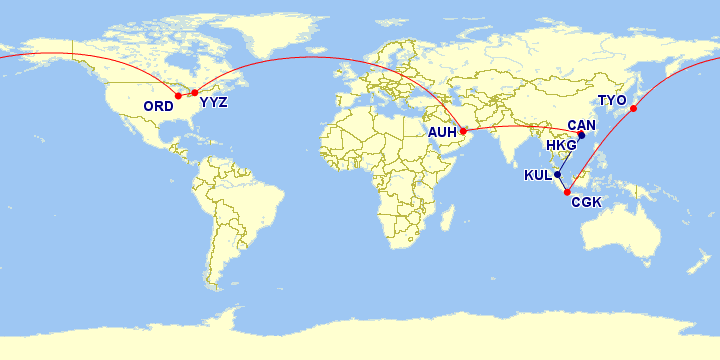
This example can be taken even further if you’re able to further leverage various sweet spots from multiple programs. It goes to show that having balances in different points currencies is an important tool to have at your disposal, and that there’s something to be said for not putting all of your eggs in one basket, so to speak.
An Illustrated Example
For the serious travellers out there who take off multiple times a year (and are therefore busy planning several trips at once), a little bit of careful planning might pay off tremendously.
The general principle here is that you tend to get the best value out of a certain program’s points when you maximize that program’s stopover and routing policies. With Aeroplan, that means a stopover in each direction, in addition to the destination.
So if, for whatever reason, you’re not maximizing the stopover rules on a certain trip, you might be able to “use” that stopover allowance towards a future trip if you can plan ahead and the circumstances allow for it. Let’s look at a few examples in detail.

Let’s imagine you’re planning to bring the family to Europe twice this year – once during the end of the summer holidays when kids are out of school, and once later on during Thanksgiving just to visit some in-laws in London.
You have a much looser schedule during summertime, meaning that you’d like to hop around Europe and see a few more places. On the other hand, you only have a week during Thanksgiving and so are looking for a simple round-trip.
Ordinarily, two round-trip bookings would give you the ability to stop in three places each, but that allowance would be “wasted” on the second trip. So what can you do?
That’s right – nested trips can help you “transfer” the stopover allowance from the second trip to the first!
North America to Europe round-trip:
YVR – CPH (stopover)
CPH – MUC (destination)
MUC – LHR (stopover)
Europe to North America round-trip:
LHR – GVA (stopover)
GVA – LIS (layover)
LIS – YVR
[end of trip 1]
[beginning of trip 2]
YVR – LHR
LHR – YVR
Summer Trip
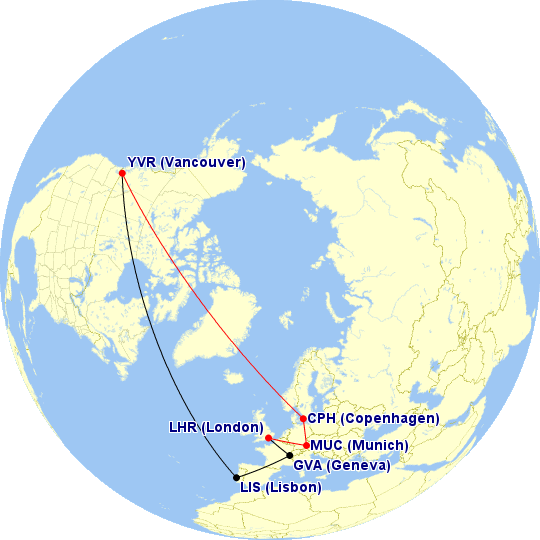
Thanksgiving Trip
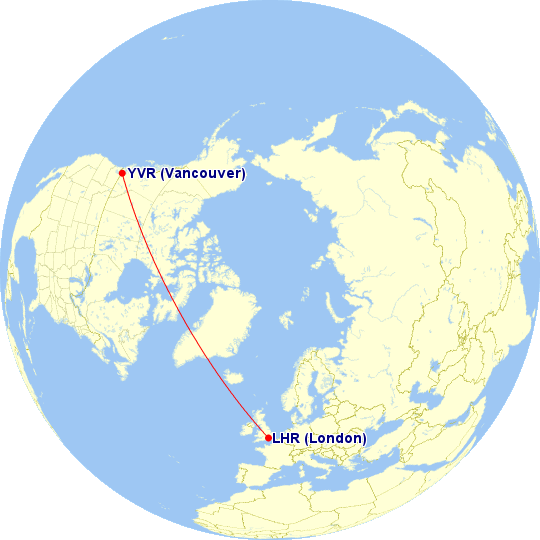
You’re making two bookings – one from Vancouver to Munich with stopovers in Copenhagen and London, and another from London to Vancouver with a stopover in Geneva and a layover of less than 24 hours in Lisbon.
However, you schedule these stops such that you’re essentially enjoying four stops in Europe during summertime (which makes for an amazing trip with the family) and a simple round-trip for Thanksgiving (which is all you need). Maximizing indeed!
Of course, you’d need to keep in mind that you can only have a stopover of up to 45 days in a city, so if you were to book the above example, you’d just want to make sure your dates line up accordingly.
This technique is most useful for travellers who 1) can plan ahead to some degree, 2) often return to the same region within a shorter time period, and 3) often don’t fully maximize the generous stopover allowance. If those describe you, then this type of nested booking should be a technique you always keep up your sleeve.
Conclusion
Once you start thinking about putting trips in-between other trips, the travel possibilities grow exponentially. With nested trips, you’re looking at a more involved trip-planning process, but in return, you might be able to see more places you want to see, and perhaps even save miles by maximizing the stopover policies in situations when they’d otherwise go to waste.
Best of all, unless you’re engaging in back-to-back ticketing to skirt around fare rules, nested tickets are a perfectly above-board booking method that won’t at all get you in trouble with the airlines. Time to get out your calendars and world maps and see what creative journeys you’re able to come up with!



















